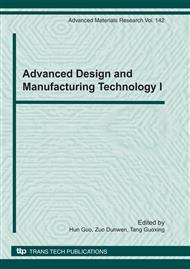[6]
It reported that the living enzyme decomposing the wood structure of cellulose, hemicelluloses, or xylogen can not be detected in salivary gland of the larva long horned beetle. The enzyme decomposing the wood structure is endogeneisd.
Google Scholar
[7]
As the severe harm of the Aphrodisium sauteri (Matsushita) on the wood of Quercus Myrsinaefolia, the observation was carried on the mouthpart, the maxilla and the tunnel on the trunk. The roughness of the tunnel can be limited to Ra2. 946μm、Rz12. 1μm、Rmax16. 1μm on the Quercus Myrsinaefolia trunk, and is less than the sawed surface. The shape of the maxilla looks like the scalper with the end of maxilla is blunt round smooth inner surface. During the eating the maxilla makes the inner surface of the tunnel smooth (seen in fig. 1). Fig. 3 The maxillae of Aphrodisium sauteri (Matsushita) Fig. 4 Maxillae shaped like tool Conclusion The bionic research on tool design is barely at beginning. It is highly valuable to use the bionic method to design metal cutting tool on the material structure and parameters. (1) For bionic design is very new in metal cutting design, few research do any work in this field. Collecting data on bio-tribology, bionic design, self-shaping tool, tribology, wear of tool and finite element method and etc. is very critical. On this base can the research worked. (2) Using Electron Microscope, Scanning Electron Microscope, Sclerometer and etc. to analyze the mouthpart of the larval long horned beetle. The result helps to realize the bionic metal cutting tool design on cutting tool material structure. (3) Using the bionic design method to analyzes different parts of the mouthpart on the metal cutting tool design; evaluate the cutting properties of the creature. The result helps to realize the bionic metal cutting tool design on cutting tool parameter design. Reference.
Google Scholar
[1]
National Natural Science Foundation Engineering and Materials Science Division: Scientific disciplines of Mechanical and Manufacturing Development Strategy Study(2006-2010)(Beijing: Science press, 2005).
Google Scholar
[2]
Cheng Fei, Huang Hairong: Hubei Plant Conservation (2009) No. 6, pp.14-18.
Google Scholar
[3]
Scherge Matthias, Gorb Stanislav S.: Biological Micro-and Nanotribology: Nature's Solutions (Beijing: Machinery Press, 2004).
Google Scholar
[4]
Xie Diwu: Spark strengthening coating from the sharpening of woodworking tools (Master Degree Dissertation, Nanjing Forestry University, 1997).
Google Scholar
[5]
Qing Zhenhua: Tool Technology Vol. (2008) No. 9, pp.4-8.
Google Scholar
[6]
Yu Yunxiang, Huang Suhong : Journal of Jiangxi Forestry technology(2007) No. 1, pp.38-40.
Google Scholar
[7]
Yin Youping, Cao Yueqing: Science of Forestry Vol. 36 (2000) No. 6, pp.33-38.
Google Scholar


